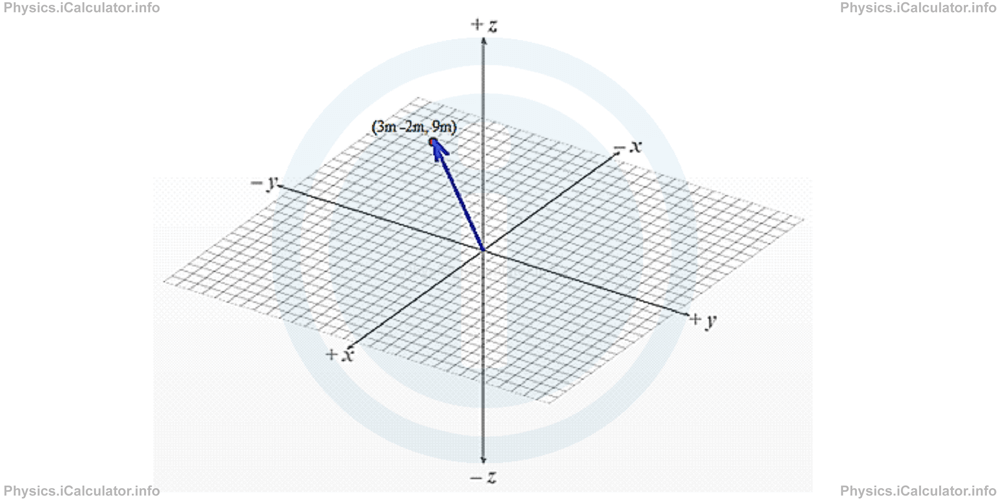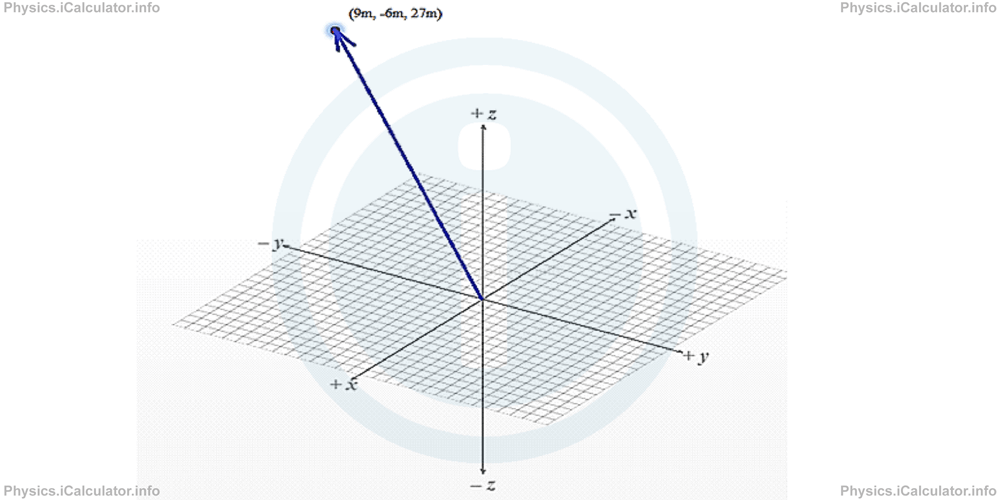Menu
Physics Lesson 2.3.4 - How to multiply a vector by a scalar in coordinates?
Please provide a rating, it takes seconds and helps us to keep this resource free for all to use
Welcome to our Physics lesson on How to multiply a vector by a scalar in coordinates?, this is the fourth lesson of our suite of physics lessons covering the topic of Multiplication of a Vector by a Scalar, you can find links to the other lessons within this tutorial and access additional physics learning resources below this lesson.
How to multiply a vector by a scalar in coordinates?
A vector is usually represented in coordinates in the following way:
(When the vector is in 2 dimensions, its z-coordinate (zv) is not written or it is simply written as 0.)
When the vector written in this way, we assume the starting point (tail) of the vector is at the origin (0, 0, 0) and the given coordinates represent only the vector tip. For example, if we say "an object is actually at (3m, -2m, 9m), we assume the object has moved 3m due positive in the x-axis, 2m due negative in the y-axis and 9m due positive in the z-axis after starting its motion from the origin. Look at the figure.

If taking the initial position of the object as (0, 0, 0), then the vector in the figure is written as
Now, let's suppose the object moves at the same direction by triple the actual displacement. It is obvious we will obtain a new vector Δx⃗2, which is collinear with ∆x⃗1 but it is 3 times longer. There is no need to plot the vector Δx⃗2 in the graph (although it is shown here) as sometimes it is not possible to show everything in the graph but we can simply multiply each coordinate by 3 instead.

It is obvious that both vectors are collinear as they lie in the same direction. However, the second vector is triple as long as the first vector.
Thus, we obtain the vector
3 × 3m3 × (-2m)3 × 9m = 9m-6m27m
Therefore, the rule says: "To multiply or divide a vector by a scalar in coordinates, we simply multiply or divide each coordinate of the original vector with the given scalar. The result represents the coordinates of the new vector."
Mathematically, we can write
The same method can be also used for the multiplication of a vector by a negative scalar of for division of a vector by a positive or negative scalar. This method is much easier than solving the questions graphically.
You have reach the end of Physics lesson 2.3.4 How to multiply a vector by a scalar in coordinates?. There are 4 lessons in this physics tutorial covering Multiplication of a Vector by a Scalar, you can access all the lessons from this tutorial below.
More Multiplication of a Vector by a Scalar Lessons and Learning Resources
Whats next?
Enjoy the "How to multiply a vector by a scalar in coordinates?" physics lesson? People who liked the "Multiplication of a Vector by a Scalar lesson found the following resources useful:
- Coordinates Feedback. Helps other - Leave a rating for this coordinates (see below)
- Vectors and Scalars Physics tutorial: Multiplication of a Vector by a Scalar. Read the Multiplication of a Vector by a Scalar physics tutorial and build your physics knowledge of Vectors and Scalars
- Vectors and Scalars Video tutorial: Multiplication of a Vector by a Scalar. Watch or listen to the Multiplication of a Vector by a Scalar video tutorial, a useful way to help you revise when travelling to and from school/college
- Vectors and Scalars Revision Notes: Multiplication of a Vector by a Scalar. Print the notes so you can revise the key points covered in the physics tutorial for Multiplication of a Vector by a Scalar
- Vectors and Scalars Practice Questions: Multiplication of a Vector by a Scalar. Test and improve your knowledge of Multiplication of a Vector by a Scalar with example questins and answers
- Check your calculations for Vectors and Scalars questions with our excellent Vectors and Scalars calculators which contain full equations and calculations clearly displayed line by line. See the Vectors and Scalars Calculators by iCalculator™ below.
- Continuing learning vectors and scalars - read our next physics tutorial: Dot (Scalar) Product of Two Vectors
Help others Learning Physics just like you
Please provide a rating, it takes seconds and helps us to keep this resource free for all to use
We hope you found this Physics lesson "Multiplication of a Vector by a Scalar" useful. If you did it would be great if you could spare the time to rate this physics lesson (simply click on the number of stars that match your assessment of this physics learning aide) and/or share on social media, this helps us identify popular tutorials and calculators and expand our free learning resources to support our users around the world have free access to expand their knowledge of physics and other disciplines.